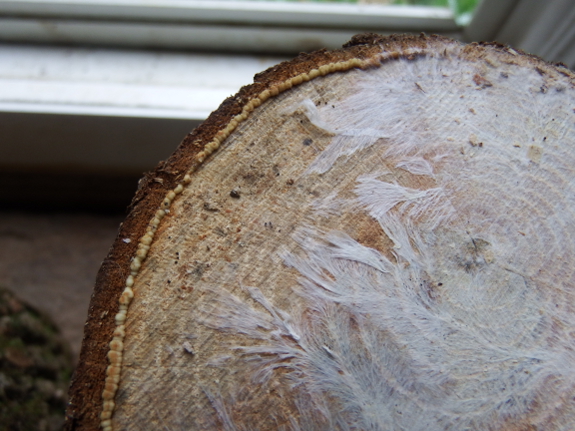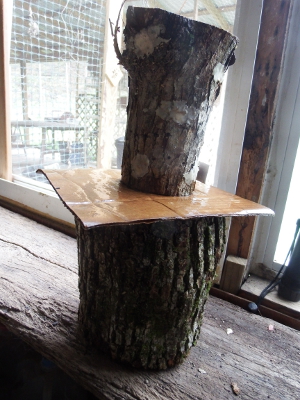
Propagating a shiitake mushroom log for free

When we inoculated three mini-logs with shiitake mycelium in late February, my primary purpose was to deal with the winter doldrums. But I also wanted to experiment with a method Tradd Cotter suggested for propagating shiitake logs without lab conditions. If you've been reading for a while, you'll know that oyster mushroom spawn is pretty easy to expand on cardboard,
but shiitake spawn is more particular. Traditional shiitake farmers
simply lay new logs beneath older, fruiting logs and hoped some spores
would take, while modern farmers get their shiitake mycelium from a lab.
 I'm
looking for something more reliable than the traditional method but
less expensive and painstaking than the modern method. Enter Tradd's
expansion totems! Once the mycelium started spreading across one end of
my mini-log (about 5 weeks after inoculation), I soaked a small sheet of
cardboard and stacked a fresh mini-log, the cardboard, and then the
colonized mini-log (with the most mycelium-rich side down). My little
tower went into a trash bag on the living room floor, which I tied
loosely closed...and then ignored for a while.
I'm
looking for something more reliable than the traditional method but
less expensive and painstaking than the modern method. Enter Tradd's
expansion totems! Once the mycelium started spreading across one end of
my mini-log (about 5 weeks after inoculation), I soaked a small sheet of
cardboard and stacked a fresh mini-log, the cardboard, and then the
colonized mini-log (with the most mycelium-rich side down). My little
tower went into a trash bag on the living room floor, which I tied
loosely closed...and then ignored for a while.
After two weeks, I took a
look inside and noticed that bad molds were starting to grow. You don't
have to be a fungal expert to tell the difference between good and bad
here --- shiitake mycelium is white, so any other color is a bad mold.
In this case, what I was seeing was little black dots on the cardboard
where the paper product stuck out past the logs. Bad molds are a sign of
excessively high humidity, so I opened up the trash bag (but also
poured a bit of water on the cardboard so it wouldn't dry out). Then I
went away for another week.

At the three-week mark, I
decided it was time for the moment of truth. Not expecting much, I
lifted off the top log...and the cardboard came along with it, proof
that the mycelium had run out of the wood and into the cardboard. So
far, so good --- but was there mycelium on the log below? Yes there was,
as you can see from the photo above!
Step two involved soaking the cardboard and both logs
for another couple of hours, then reassembling, this time with the
untouched side of the newly colonized log up. I'm pretty confident now
that this log-colonization method works, so the next experiment will
answer the question: are these mini-logs big enough to be worth
fruiting, or do I need to let multiple mini-logs fuse together before
asking the mycelium to make me a mushroom? Stay tuned for further experiments as the summer progresses.
Want more in-depth information? Browse through our books.
Or explore more posts by date or by subject.
About us: Anna Hess and Mark Hamilton spent over a decade living self-sufficiently in the mountains of Virginia before moving north to start over from scratch in the foothills of Ohio. They've experimented with permaculture, no-till gardening, trailersteading, home-based microbusinesses and much more, writing about their adventures in both blogs and books.
Want to be notified when new comments are posted on this page? Click on the RSS button after you add a comment to subscribe to the comment feed, or simply check the box beside "email replies to me" while writing your comment.
- Remove comment
